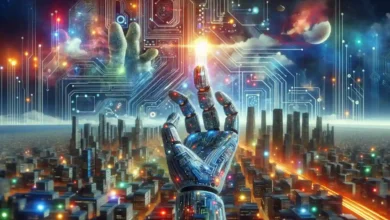Living Like Billionaires by 2050: The Dawn of Personal AI Agents and Robotic Labor

Imagine waking up in 2050 to a world where luxury isn’t reserved for the elite, it’s your everyday reality. Your personal AI agents have already scheduled your day, negotiated a bespoke vacation package at a fraction of today’s costs, and invested your passive income into ventures that multiply your wealth while you sleep. Meanwhile, your robotic companions handle everything from household chores to running a side business, plugging seamlessly into global automated supply chains. This isn’t science fiction; it’s the logical endpoint of current AI and robotics trends. But what does this mean for society, work, and human purpose? In this deep dive, we’ll explore how agentic AI autonomous systems that act independently on your behalf, combined with advanced robotics could democratize billionaire-level living, sparking an era of on-demand abundance where luxury becomes the default.
The Billionaire Benchmark: What “Luxury as Default” Really Means
Today’s billionaires like Elon Musk or Jeff Bezos live in a realm of effortless abundance. Private jets on demand, personal chefs crafting meals from global ingredients, and armies of assistants managing investments, travel, and even social calendars. They don’t wait in lines, haggle over prices, or worry about mundane tasks and their wealth generates more wealth through networks of people and systems.
By 2050, experts predict this lifestyle could be accessible to everyone, thanks to exponential advances in AI and robotics. Ray Kurzweil, often called the “godfather of AI,” foresees a world where artificial intelligence masters human-like capabilities, ending scarcity in key areas like healthcare and energy. Goldman Sachs estimates that up to 50% of jobs could be fully automated by 2045, with robotics playing a pivotal role, leading to a surge in productivity that floods the economy with goods and services.
Picture this: No more 9-to-5 grind. Your AI+robot duo acts as your personal empire-builder, turning idle time into value creation. But how do we get there? It starts with the evolution of personal AI staff, the agentic systems that don’t just assist but anticipate, negotiate, and innovate for you.
Personal AI Staff: Your 24/7 Autonomous Ally in the Abundance Era
In 2050, every individual could have a hyper-personalized AI agent, far beyond today’s Siri or Alexa. These agentic AIs, capable of independent decision-making, learning from your preferences, and executing complex tasks, will function like a digital twin, handling life’s logistics with superhuman efficiency.
Consider the mechanics: Your AI scans your health data to predict illnesses before symptoms arise, booking virtual consultations with AI-driven specialists that diagnose with 99% accuracy. It negotiates utility bills, trades stocks in real-time based on global events, and even creates custom content, like personalized novels or music playlists, that you could sell online. Powered by advancements in large language models (LLMs) and artificial general intelligence (AGI), which experts say could arrive between 2040 and 2050 with over 50% probability, these agents will integrate seamlessly with your life.
Thought-provoking question: What if your AI knows you better than you know yourself? It could optimize your diet for longevity, curate educational paths for your children, or even mediate family disputes using empathy algorithms trained on billions of human interactions. This isn’t passive assistance; it’s proactive agency, where your AI plugs into decentralized networks to trade services, barter resources, and generate income streams. As one prediction notes, by 2050, AI will reshape personal convenience, making agents indispensable for everything from home management to career advancement.
But AI alone isn’t enough; enter robotic labor, the physical counterpart that turns digital decisions into tangible results.
Robotic Labor: From Factory Floors to Home Empires
Robotics will be the muscle to AI’s brain, enabling on-demand abundance through tireless, precise automation. Morgan Stanley projects the humanoid robot market could hit $5 trillion by 2050, with nearly 1 billion units in operation, led by innovations from countries like China. These aren’t clunky machines; they’re agile, learning robots that adapt to tasks in real-time.
In your 2050 home, a robotic duo might include a multifunctional humanoid for chores—like cooking gourmet meals from automated urban farms, and specialized bots for maintenance, such as drone-like repair units that fix appliances before they break. On a broader scale, robots will dominate industries: Agriculture becomes vertical farming towers run by AI-optimized bots, producing food at pennies per calorie; manufacturing shifts to 3D-printed goods delivered via autonomous drones.
The synergy? Your personal AI directs these robots to create products, say, custom apparel or artisanal goods, that plug into global supply chains. A report from the Future of Work initiative at Stanford highlights that LLMs could affect 80% of U.S. workers’ tasks, with robotics amplifying this to full automation in physical domains. This leads to an abundance economy where scarcity evaporates, but it raises a provocative dilemma: If robots do all the work, what do humans do?
On-Demand Abundance: Redefining Economics in a Post-Scarcity World
The core of this 2050 vision is an “abundance economy,” where AI and robotics drive costs to near-zero across sectors like food, energy, and healthcare. Zoltan Istvan, a transhumanist thinker, proposes an automated model where AI eliminates waste, creating exponential growth.
Key enablers:
- Energy Abundance: Fusion power, managed by AI, provides unlimited clean energy, making electric vehicles and smart homes ubiquitous.
- Healthcare Revolution: AI predicts and prevents diseases, with robotic surgeons performing flawless operations, potentially ending aging as Kurzweil predicts.
- Education and Creativity: Personalized AI tutors democratize Ivy League-level learning, fostering innovation.
Yet, this abundance isn’t automatic. As one analysis warns, if AI and robots are owned by elites, it could exacerbate inequality. Universal basic income (UBI), funded by taxes on automated production, might become standard, ensuring wealth flows back to individuals. McKinsey forecasts that automation could displace millions but also boost global GDP by lifting productivity.
Curiosity hook: Could this lead to a “post-work” society where humans pursue passions, or will it spark new conflicts over resource distribution?
Your AI+Robot Duo: 24/7 Value Generators in Automated Supply Chains
At the heart of billionaire-level living is passive wealth creation. Your AI agent, paired with robots, operates as a autonomous business unit: It identifies market gaps, designs products using generative AI, manufactures them via robotic fabs, and sells through blockchain-secured platforms.
For instance:
- Task Handling: AI schedules and optimizes daily routines, freeing you for leisure.
- Product Creation: Robots 3D-print custom gadgets, which AI markets globally.
- Negotiation and Trade: Agentic AI barters in real-time auctions, securing deals better than human traders.
- Supply Chain Integration: Plugs into decentralized networks, like AI-managed logistics hubs, ensuring seamless delivery.
Predictions suggest over 20 billion non-human workers by 2050, transforming industries and enabling this personal economy. The wealth generated? It flows directly to you, perhaps through digital wallets or tokenized assets, making everyone a micro-entrepreneur.
Societal Shifts: Opportunities, Challenges, and Ethical Quandaries
This utopia isn’t without shadows. While AI could eliminate neurological disorders and boost longevity, it might also lead to mass unemployment, IMF estimates that 40% of global jobs affected. Peter Diamandis warns of an “abundance trap” where ownership determines prosperity.
Thought-provoking implications:
- Inequality Risks: Without equitable policies, a new aristocracy of AI owners could emerge.
- Human Purpose: With work optional, will we thrive in creativity or succumb to ennui?
- Ethical AI: Ensuring agentic systems align with human values, preventing biases or misuse.
Counterarguments? Some experts argue AI will create more jobs than it destroys, in fields like AI ethics and creative oversight. A TIME magazine roadmap to AI utopia emphasizes new metrics for success beyond GDP.
Embracing the Future: Will You Be Ready for Billionaire Living?
By 2050, the fusion of personal AI agents and robotic labor could make today’s luxuries tomorrow’s norms, ushering in an era of universal abundance. But this future hinges on choices we make now, regulating AI, redistributing wealth, and redefining value in a post-scarcity world. What role will you play? Will you let your AI duo build your empire, or shape the systems that govern it? The path to living like billionaires is paved with innovation, but it’s our collective agency that will determine if it’s a privilege or a right for all. Dive deeper into these trends and start preparing— the abundance revolution is closer than you think.
Disclaimer
The content of this blog post is a speculative exploration of potential technological advancements and their societal impacts by 2050. The scenarios described, including the widespread adoption of personal AI agents, robotic labor, and universal abundance, are imaginative projections based on current trends and expert predictions. Actual outcomes will depend heavily on the pace and direction of technological progress, as well as economic, political, and social developments. The information presented is for informational and thought-provoking purposes only and should not be considered a definitive forecast or guarantee of future events.
Follow Odinozz on social media. Click here.



